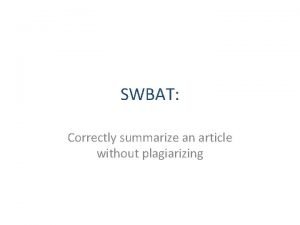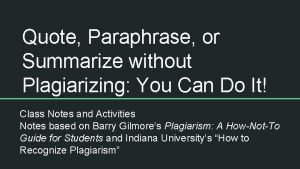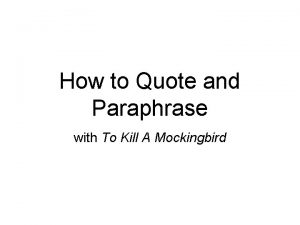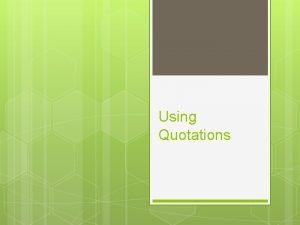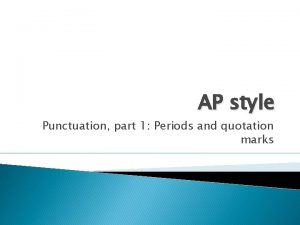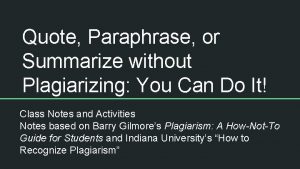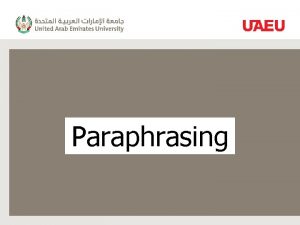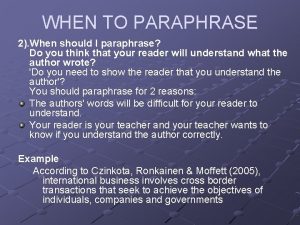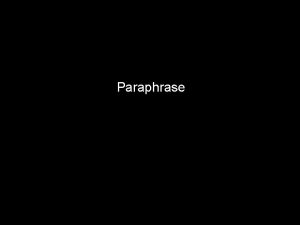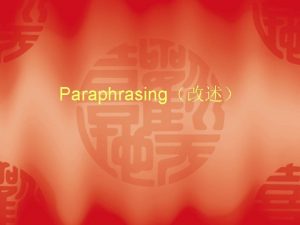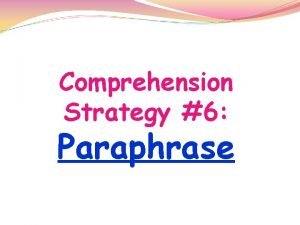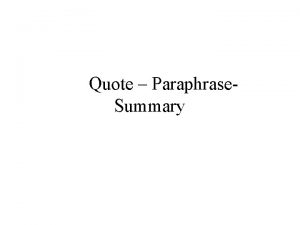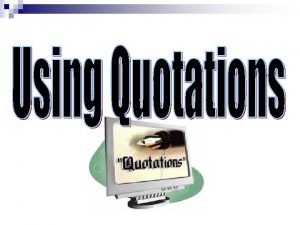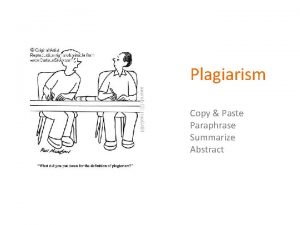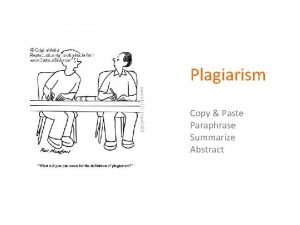Quote Paraphrase or Summarize without Plagiarizing You Can



![Plagiarism defined: Gilmore defines plagiarism as follows: “appropriating [taking] any material--ideas, writing, images, or Plagiarism defined: Gilmore defines plagiarism as follows: “appropriating [taking] any material--ideas, writing, images, or](https://slidetodoc.com/presentation_image_h/ce9d22f1ba83d1585e79fbd3911c5310/image-4.jpg)












- Slides: 16

Quote, Paraphrase, or Summarize without Plagiarizing: You Can Do It! Class Notes and Activities Notes based on Barry Gilmore’s Plagiarism: A How-Not-To Guide for Students and Indiana University’s “How to Recognize Plagiarism”

Dilemma: What about collaboration and plagiarism/cheating? “ 85 Ohio State Veterinary Students Disciplined for Cheating” Rachael Zimlich, dvm 360 List three of the gray areas that arise with collaboration. When does collaboration become cheating or plagiarism?

Why shouldn’t I plagiarize? According to Indiana University’s “How To Recognize Plagiarism”: It is a matter of respect and integrity. When you borrow someone else’s words and ideas and give them proper credit, “you are not misleading the reader to believe that your ideas and words are solely your own” (n. p. ) Common knowledge also tells us: It is a matter of trust and work ethic. Your work should be a representation of what you know and can do. Trust me to be there for you when you need help. Develop a work ethic that allows you to truly engage in your education.
![Plagiarism defined Gilmore defines plagiarism as follows appropriating taking any materialideas writing images or Plagiarism defined: Gilmore defines plagiarism as follows: “appropriating [taking] any material--ideas, writing, images, or](https://slidetodoc.com/presentation_image_h/ce9d22f1ba83d1585e79fbd3911c5310/image-4.jpg)
Plagiarism defined: Gilmore defines plagiarism as follows: “appropriating [taking] any material--ideas, writing, images, or portions of those-and claiming to be the original creator” (7). IU’s definition is similar: “If you directly copy or summarize someone else’s words or ideas without acknowledging the source this is plagiarism” (n. p. ).

Why quote? Gilmore says we should quote when we want to “include words or phrases originally written by another author” and “when you wish to emphasize the language or phrasing of an original source” (25). In other words, when the most powerful way to make your point is to use another author’s words, quoting is a good idea.

What does it mean to paraphrase and why do it? Paraphrase: to use different words than an author has used to capture the author’s intended meaning in a clearer, more concise manner Why do it? Gilmore notes that it is best to paraphrase “to avoid including an overly long quotation in your work” (25). Additionally, Gilmore explains that paraphrasing allows you to simplify “technical or complicated” ideas and information in a brief manner (25).

What does it mean to summarize and why do it? Summarize: to boil a large amount of text down to its main idea or overall gist Why do it? Gilmore notes that it is best to summarize “when the overall information is important but the details are not” (25). It allows you to discuss a big idea more efficiently than quoting or paraphrasing. It allows you to synthesize the author’s main points briefly and to devote more time to developing your own original ideas.

Commonalities Information based on Gilmore’s figure 2. 4 (25 -7): Citation Needed Maintain Author’s Intended Meaning Provide Context to Clue-In the Reader that Which Info is Borrowed Use Your Own Words and Phrasing Quote X X X Paraphrase X X Summarize X X

Word-for-Word Plagiarism vs. Paraphrasing Plagiarism Word-for-Word (directly from Indiana University’s “Plagiarism Certification Test”): 1. borrows ideas from the original source material, and 2. takes seven or more words in sequence from the original source material, and 3. lacks any of the following: quotation marks surrounding the words taken, or the full in-text citation [. . . ] or the bibliographic reference [a. k. a. the works cited]. (n. p. ) Paraphrasing Plagiarism (directly from Indiana University’s “Plagiarism Certification Test”): 1. borrows ideas from the original source material, and 2. is not word-for-word plagiarism, and 3. lacks any of the following: the in-text citation with author name(s) [and full in-text citation], or the bibliographic reference.

Paraphrase and Summarize Activity - Paraphrase the underlined portion in one sentence. - Paraphrase the italicized portion in one sentence. — Challenge: You have to give credit to Burg et al. AND Gilmore. - Summarize Gilmore’s main idea for chapter 2 in one sentence—your sentence should address ways students plagiarize, behaviors that lead to plagiarism, and how to avoid plagiarism.

Paraphrase Example Gilmore explains that paraphrasing is acceptable when students cite their sources, but the issue is that many have not mastered it (20).

Paraphrase Example Gilmore cites Burg et al. who say students run into trouble with paraphrasing for not giving credit to sources, taking sloppy notes without tracking sources, and paraphrasing too much (20).

Summary Example Although it is extremely easy to plagiarize, when students fully understand plagiarism and its consequences and are taught how to avoid it by giving credit to their sources, cases of plagiarism will occur less frequently.

Dilemma: Do we think of plagiarism the same way as we do other types of cheating? Should we? Why? “ 40 Years Later, Anti-Doping Calls at the Olympics Grow Louder” (National Public Radio) In your notebooks, list at least 3 ways plagiarism is like doping and 3 ways it is not. Should we see these 2 types of cheating the same? Why? Can you think of other types of cheating that are like doping and/or plagiarism?

Dilemma: Why do people insist they are not plagiarizing even when they are caught red-handed? “Melania Trump and Michelle Obama Side-by-Side Comparison” (CNN) “The Evolution of Trump Campaign Responses to Melania Trump’s Plagiarized Speech” (Reilly)

References Gilmore, Barry. Plagiarism: A How-Not-To Guide for Students. Portsmouth: Heinemann, 2009. “How to Recognize Plagiarism. ” Indiana University School of Education, 2016.
 Summarize an article without plagiarizing
Summarize an article without plagiarizing How to summarize without plagiarizing
How to summarize without plagiarizing If you cant measure it you cant manage it
If you cant measure it you cant manage it If you think you can you can poem
If you think you can you can poem Rephrasing someone else’s ideas without citation.
Rephrasing someone else’s ideas without citation. Paraphrase sentence example
Paraphrase sentence example If you can imagine it you can achieve it
If you can imagine it you can achieve it If you can't measure it you can't control it
If you can't measure it you can't control it You cant manage what you cant measure
You cant manage what you cant measure Vertikale bilanzkennzahlen
Vertikale bilanzkennzahlen Direct quotes examples
Direct quotes examples You can quote me on that
You can quote me on that How to quote a quote apa
How to quote a quote apa Dialogue quote vs flow quote
Dialogue quote vs flow quote Integrate quotes
Integrate quotes Dialogue quote vs flow quote
Dialogue quote vs flow quote Ap style quotes
Ap style quotes
